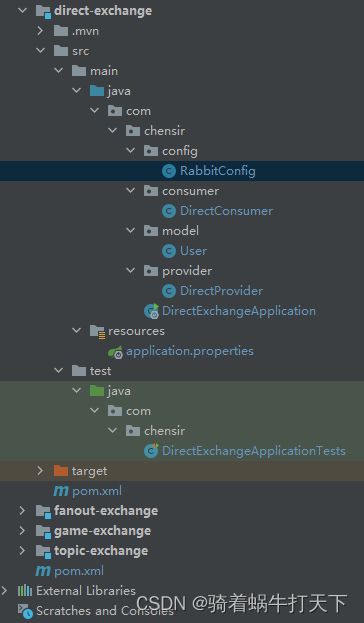DirectExchange直连交换机
目录
一、简介
二、使用步骤
三、demo
父pom文件
pom文件
配置文件
config
消费者
生产者
测试
一、简介
直连型交换机,根据消息携带的路由键将消息投递给对应队列。
大致流程,有一个队列绑定到一个直连交换机上,同时赋予一个路由键 routing key 。
然后当一个消息携带着路由值为abc,这个消息通过生产者发送给交换机时,交换机就会根据这个路由值abc去寻找绑定值也是X的队列。
二、使用步骤
* * 步骤: * 1、交换机注入bean * 2、队列注入bean * 3、队列与交换机绑定 * 注意:虽然交换机、队列、绑定关系都已注入bean中,但是rabbitMQ中还是没有创建的交换机和队列。 * 那是因为消费者还未创建,当消费者创建并与队列绑定后就能在rabbitMQ服务中看到创建的交换机和队列; * 那么,若想在rabbitMQ服务中查看到创建的交换机和队列,还需要第4步,创建消费者 * 4、创建消费者consumer
三、demo
父pom文件
4.0.0
org.springframework.boot
spring-boot-starter-parent
2.7.1
com.chensir
spring-boot-rabbitmq
0.0.1-SNAPSHOT
spring-boot-rabbitmq
8
5.8.3
1.18.24
spring-boot-rabbitmq
pom
direct-exchange
fanout-exchange
topic-exchange
game-exchange
dead-letter-queue
delay-queue
delay-queue2
cn.hutool
hutool-all
${hutool.version}
org.projectlombok
lombok
${lombok.version}
pom文件
4.0.0
com.chensir
spring-boot-rabbitmq
0.0.1-SNAPSHOT
../pom.xml
direct-exchange
cn.hutool
hutool-all
org.projectlombok
lombok
true
org.springframework.boot
spring-boot-starter-amqp
org.springframework.boot
spring-boot-starter-web
org.springframework.boot
spring-boot-starter-test
test
org.springframework.amqp
spring-rabbit-test
test
org.springframework.boot
spring-boot-maven-plugin
配置文件
server.port=8081
logging.level.com.chensir=debug
#host
spring.rabbitmq.host=121.40.100.52
#默认5672
spring.rabbitmq.port=5672
#用户名
spring.rabbitmq.username=guest
#密码
spring.rabbitmq.password=guest
#连接到代理时用的虚拟主机
spring.rabbitmq.virtual-host=/
#每个消费者每次可最大处理的nack消息数量 默认是250个 可在服务界面看到;意思是每批投递的数量
spring.rabbitmq.listener.simple.prefetch=1
#表示消息确认方式,其有三种配置方式,分别是none、manual(手动)和auto(自动);默认auto
spring.rabbitmq.listener.simple.acknowledge-mode=auto
#监听重试是否可用
spring.rabbitmq.listener.simple.retry.enabled=true
#最大重试次数
#spring.rabbitmq.listener.simple.retry.max-attempts=5
#最大重试时间间隔
spring.rabbitmq.listener.simple.retry.max-interval=20000ms
#第一次和第二次尝试传递消息的时间间隔
spring.rabbitmq.listener.simple.retry.initial-interval=3000ms
#应用于上一重试间隔的乘数
spring.rabbitmq.listener.simple.retry.multiplier=2
#决定被拒绝的消息是否重新入队;默认是true(与参数acknowledge-mode有关系)
spring.rabbitmq.listener.simple.default-requeue-rejected=false
config
在config中去注入交换机、队列、以及配置队列与交换机的绑定;
一个交换机可以有多个队列与之绑定;
一个队列可以多个消费者绑定消费;
下面为config注入bean的方式;还有种使用注解的方式(使用注解则不需要config配置,但是需要在每个消费者上使用注解配置,这样的缺点有不方便管理)
config注入
package com.chensir.config;
import org.springframework.amqp.core.*;
import org.springframework.amqp.support.converter.Jackson2JsonMessageConverter;
import org.springframework.context.annotation.Bean;
import org.springframework.context.annotation.Configuration;
/**
* 步骤:
* 1、交换机注入bean
* 2、队列注入bean
* 3、队列与交换机绑定
* 注意:虽然交换机、队列、绑定关系都已注入bean中,但是rabbitMQ中还是没有创建的交换机和队列。
* 那是因为消费者还未创建,当消费者创建并与队列绑定后就能在rabbitMQ服务中看到创建的交换机和队列;
* 那么,若想在rabbitMQ服务中查看到创建的交换机和队列,还需要第4步,创建消费者
* 4、创建消费者consumer
*/
@Configuration
public class RabbitConfig {
//解决对象类型乱码 默认的对象类型时base64
@Bean
public Jackson2JsonMessageConverter messageConverter(){
return new Jackson2JsonMessageConverter();
}
/**
* 直连交换机 一个交换机可绑定多个队列
*/
@Bean
public DirectExchange directExchange(){
// name:交换机名称 durable:是否持久化 autoDelete:是否自动删除(没人用时是否自动删除)
DirectExchange directExchange = new DirectExchange("DirectExchange-01", true, false);
return directExchange;
}
/**
* 队列 一个队列可多个消费者使用
* @return
*/
@Bean
public Queue directQueue(){
//autoDelete() 队列自动删除,当消费者不存在,队列自动删除;注意,这个并不常用!容易丢失消息(队列本来就是存放消息的,自动删除就没意义了)
// Queue queue = QueueBuilder.durable("DirectQueue-01").autoDelete().build();
//durable 持久化;持久化到server硬盘中; 使用这个后每次本地服务(项目)重启 rabbitMQ服务上会自动创建此队列
Queue queue = QueueBuilder.durable("DirectQueue-01").build();
return queue;
}
/**
* 绑定队列与交换机
* @return
*/
@Bean
public Binding binding(){
//绑定directQueue这个队列给 directExchange 这个交换机
Binding binding = BindingBuilder.bind(directQueue()).to(directExchange()).with("Direct-RoutingKey-01");
return binding;
}
// @Bean
// public Queue directQueue2(){
// Queue queue = QueueBuilder.durable("DirectQueue-02").autoDelete().build();
// Queue queue = QueueBuilder.durable("DirectQueue-02").build();
// return queue;
// }
/**
* 也与交换机DirectExchange-01 绑定;一个交换机可以绑定多个队列
* @return
*/
// @Bean
// public Binding binding2(){
// Binding binding = BindingBuilder.bind(directQueue2()).to(directExchange()).with("Direct-RoutingKey-01");
// return binding;
// }
}
使用注解
使用注解需要在消费者上使用注解并把交换机、队列、key值配置上去即可;
使用了注解方式就不需要在config中配置了。
@RabbitHandler
@RabbitListener(bindings = @QueueBinding(
value = @Queue(value = "DirectQueue-01",durable = "true",autoDelete = "false"),
exchange = @Exchange(value = "DirectExchange-01",type = ExchangeTypes.DIRECT),
key = "Direct-RoutingKey-01"
))
// @RabbitListener(queues = {"DirectQueue-01","DirectQueue-02"})
public void process2(Message message) {
System.out.println(message);
String test = new String(message.getBody());
System.out.println("消费2消费了"+test);
}消费者
package com.chensir.consumer;
import cn.hutool.json.JSONUtil;
import com.chensir.model.User;
import lombok.extern.slf4j.Slf4j;
import com.rabbitmq.client.Channel;
import org.springframework.amqp.core.ExchangeTypes;
import org.springframework.amqp.core.Message;
import org.springframework.amqp.rabbit.annotation.*;
import org.springframework.stereotype.Component;
import java.io.IOException;
/**
* 消费者
*/
@Component
@Slf4j
public class DirectConsumer {
/**
* 消费者process 消费DirectQueue-01队列;可多个消费之消费同一个队列
*
* @param message
*/
@RabbitHandler
@RabbitListener(queues = "DirectQueue-01")
// @RabbitListener(queues = {"DirectQueue-01","DirectQueue-02"})
public void process(Message message) {
System.out.println(message);
String test = new String(message.getBody());
System.out.println("消费1消费了" + test);
}
/**
* 消费者process2 也消费DirectQueue-01队列;与消费者process验证多个消费者消费同一个队列
* @param message
*/
@RabbitHandler
@RabbitListener(queues = "DirectQueue-01")
public void process2(Message message) {
System.out.println(message);
String test = new String(message.getBody());
System.out.println("消费2消费了" + test);
}
}
生产者
package com.chensir.provider;
import com.chensir.model.User;
import lombok.extern.slf4j.Slf4j;
import org.springframework.amqp.core.Message;
import org.springframework.amqp.core.MessageProperties;
import org.springframework.amqp.core.ReturnedMessage;
import org.springframework.amqp.rabbit.connection.CorrelationData;
import org.springframework.amqp.rabbit.core.RabbitTemplate;
import org.springframework.stereotype.Component;
import javax.annotation.PostConstruct;
import javax.annotation.Resource;
import java.io.UnsupportedEncodingException;
import java.nio.charset.StandardCharsets;
/**
* 生产者
*/
@Component
@Slf4j
public class DirectProvider {
@Resource
private RabbitTemplate rabbitTemplate;
/**
* 生产者-简单的发送消息
*/
public void send0() {
// TODO: 2023/8/25 消息内容若为字符串则会报消息类型不匹配的错误,数字可以正常发生与接受,记得22年测试中文时可以成功发送与接收。
Message message = new Message(("这是生产者发送的消息").getBytes());
// 往DirectExchange-01交换机中发送消息,交换机的密钥为Direct-RoutingKey-01
// rabbitTemplate.send("DirectExchange-01", "Direct-RoutingKey-01", message);
rabbitTemplate.convertAndSend("DirectExchange-01", "Direct-RoutingKey-01", message);
}
}测试


